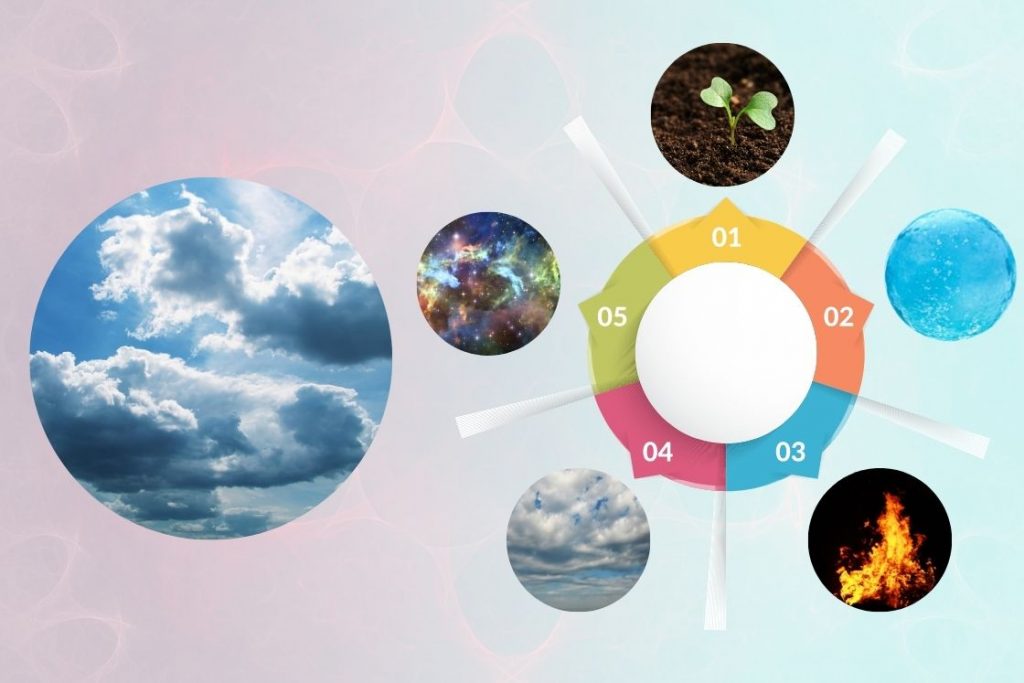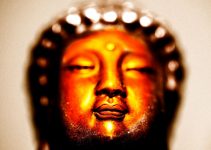
Air is something that you cannot imagine living without. The most common association of air is our breath. It is through breathing that all living organisms are able to survive. Air is also one of the most important elements that make up the human body.
It is the second element of the 5 great elements (Pancha mahabhutus) and is known as Vayu in Sanskrit. Air evolves from the ether when the inherent potential of space becomes active. All the movement or force that is a result of kinetic energy is air.
The basic qualities of air are mobile, cool, light, dry, rough, subtle, flowing, sharp, clear, and hard. The sense of touch is the subtle manifestation of this element. And the skin is one such organ that is related to the air element due to this manifestation.
Any movement that is going on in our body – your thoughts, the blood flow, the signals from the brains, the act of breathing, the digestive flow are all possible due to the air element.
In this article, we will discover the symbolism of the air element, signs of any imbalances can be and ways to connect to this element.
The symbolism of the air element
When we think of air, we often think of communication, breath, and life. Lightness, motion, intelligence, knowledge, learning, thinking, imagination, creativity, harmony, perception, and strategy also represent this element.
Ancient rishis have acknowledged air as being the immediate source of life as it is typically associated with the air we breathe.
Let us see some more symbolism of the air element
Ayurveda
The air and ether elements combined make up the Vata Dosha. This dosha is akin to a remote control that controls all the activities that your body performs consciously or unconsciously. Activities like the movement of body parts, blinking of eyes, the flow of blood and oxygen, transportation of nutrients, process of elimination from the body, etc are all responsibilities of the Vata dosha.
The air element is the dominant out of the two hence the qualities of this dosha also are similar to this element.
As per Ayurveda, the Vata dosha is present in our body in form of 5 prana vayus – Prana Vata, Udana Vata, Vyana Vata, Samana Vata, and Apana Vata.
Prana Vata (brain, lungs, heart) – Prana is the basic life force. This vata is responsible for the functioning of all the mechanisms needed for survival. This energy flows from the head to the rest of the body.
Udana Vata (respiratory system and speech organs) – It is responsible for breathing and movement of the vocal cords for speech. Udana also signifies the upward flow of vayu.
Vyana Vata (all-pervading) – Vyana is the outward flow of the vayu. This vata is responsible for muscle flexion, blood circulation, and all involuntary action inside the body.
Samana Vata (stomach, intestine, liver) – Samana is the pull of vayu towards the center. This vata is responsible for the digestion of food, absorbing all its nutrients, and excreting waste through urine or sweat.
Apana Vata (lower body) – Apana is the downward flow of Vayu. This vata takes care of waste elimination through fecal matter. The vata is said to specifically reside in the colon.
The season for Vata dosha is said to be from late fall to winter and is generally active in old age. Pre-dawn (2 am to 6 am) and late afternoon (2 pm to 6 pm) are said to be the time when this vata is most dominant. This is also one of the reasons it said to wake up early in the morning to keep this dosha balanced.
Traditional Chinese Medicine
It will be interesting to know that in TCM, the air is not identified as one of the 5 essential elements. However, their concept of Qi or chi, which is the “life force” that exists in every living being comes close to the air element.
Spiritual, Historical and Cultural
In the early Mesopotamian civilization, Enlil was worshipped as the God of Air. Shu, the God of air in ancient Egypt was seen as the symbol of strength.
The ancient Greek philosopher Plato described the air element as being hot and wet. His student Aristotle further said that air was hot and wet and also stood between fire and water. As per their medicine, blood and the season of spring were linked to the air element.
In Hinduism, Vayu is known as the God of wind and breath and is said to be the spiritual father of Lord Hanuman and Bhima. The Sanskrit words Vata, Vayu, and Prana are all somehow related to air. It is also because of this the deity Vayu is also referred to as Mukhya-Vāyu (the chief Vayu) or Mukhya Prāna (the chief of life force or vital force).
In Buddhism, Vayu is said to be one of the dharmapala, wrathful deities who willingly protect, defend, and guard the Buddhists against any danger and enemies.
Chakra
The Anahata or Heart Chakra is said to be the chakra linked to the air element. The heart is also considered to be where our soul and life energy reside. And as per Ayurveda, it is also one of the places where the Prana Vata is located.
Feelings of Love, freedom, openness, mobility, frivolity, positivity, intellect, which are also the characteristics of this chakra, can be greatly felt when your air element is optimally balanced.
Functions of the Air Element

Air, out of all the elements, has the greatest ability to cleanse the body of pollutants. This is partly due to the fact that it stokes the fire element in our bodies and minds. It’s also because air is considered the life force, the prana, that it automatically purifies us when it circulates through the body.
The air element aids in all the voluntary and involuntary movements happening within the body. Movements such as
- Breathing
- Heartbeat
- Blood and oxygen circulation
- Movement of food through the digestive organs
- The flow of thoughts and ideas in your brain
- Generating hormones and neurotransmitters
- Sending signals to various body parts through the nerves
- The movement of your arms and legs for various activities
- Blinking of the eyes, yawning, sneezing, sleeping
- Optimal functioning of sensory organs
are some basic functions this element performs.
Imbalance in the air element
Imbalances can be caused due to multi-tasking, spending long hours in front of a computer, raw or processed food, intensive exercise, smoking, excessive travelling, stress, grief, surgery, childbirth, late-night activity, or irregular schedules.
The imbalance can be in the form of excessive or deficient air element. You can detect the type of imbalance from the following signs.
Excess of the air element
- Hyper-excitability, hyper-mobility
- Diarrhea
- Rapid heart rate
- Gas and bloating
- Unsteady or scattered mind, spacy
- Ungrounded
- Insomnia
- Asthma or erratic breathing
- Severe depletion of energy
Deficiency of the air element
- Sluggishness and dullness
- Loss of motion
- Giddiness
- Weak senses
- Severe constipation or complete obstruction
- Frozen joint
- Dry skin
- Poor circulation
- Laziness, lack of creative ideas, bored
Practices to balance the air element
With the help of proper diet, exercise, yoga, small lifestyle changes you can easily counter the above-mentioned imbalances easily. You will be able to experience enthusiasm, mental alertness, ease of breathing, better circulation, proper sleep, and better mobility.
Have a look at how you can connect with your air element.
In case of excess
- Include foods that are cooling and grounding such as carrots, cucumber, flax seeds, beetroot, etc. Avoid eating raw foods.
- Savor each bite of your meal. Never skip your meals as it can lead to acidity.
- Avoid caffeine and other stimulants like alcohol.
- Build a healthy sleeping pattern. Shut off your computer, tablet, phone, etc 1-2 hours before you go to bed.
- Most pranayama such as Nadi Shodhana (alternate nostril breathing) will help in controlling your breathing.
- Astringent and bitter foods help in removing excess swelling, aids in wound repair, and give a sense of lightness. Kale, Brussel Sprouts, beans, lentils, and green leafy vegetables, pomegranates, black tea, legumes, and artichokes are some great options to include in your meal.
- Practice Aakash Mudra by joining the tips of the middle finger and the thumb to decrease the air element. Vayu Mudra can also be practiced by placing the tip of your index finger at the base of the thumb and gently pressing the back of the finger with the thumb.
- Take up constructive activities to shake off nervous energy and stay away from anxiety-causing news.
In case of deficiency
- Include air-increasing foods in your diet such as pineapple, orange, apples, oats, brown rice, basil, cinnamon, coriander, strawberries, cloves, etc.
- Spend some time feeling the breeze on your skin. Smell the freshness of the flowers in your garden or take a walk in the park. If possible, open your windows to let fresh air come in.
- Take up meditation practice where you are focusing more on your breath.
- Perform chest opening yoga poses such as Cobra Pose, Cat/Cow Pose, Bow Pose, Bridge Pose to connect more deeply to the air element. They increase your lung capacity by opening your chest and will also make you more aware of your breath.
- Practice Gyan Mudra, also known as Vaayu Vardhak Mudra to increase the air element. To practice, place the tip of your thumb on the tip of your index finger while keeping the other fingers straight yet relaxed.
- Try activities that encourage and bring out your creative side.
Conclusion
The air element is responsible for each and every movement of your body. Imagine yourself in a state where you cannot move or perform your favorite activities. Your life will be completely useless.
Hence stay as close to reality and feel the occasional breeze. Look at the fluttering leaves and breath in the fresh morning air to get energized. Air is all around you, you just need to find the means and ways to connect with it.





One of my friends told me to do this. Holding vyana mudra and swing the hands up and down, bend the knees a little and with forceful inhalation and exhalation. like this he told me to do it with apana mudra, prana mudra, udana, and samana. He was telling me my apana vayu and udana vayu is imbalanced. Bcz of Apana vayu I am having frequent urination. Can you please explain this if possible.
Abhishek as far as my experience, I haven’t come across any such mudra practice where hand swinging is advised. In most cases, a stationary hand with mudra is considered good to create pranic effects in the body. Yeah, you can incorporate the breathing part with mudra but that too shouldn’t be done with every other mudra.
The five mudras that are mentioned above are related to the 5 prana vayus in our body.
As your symptoms are of aggravated Vata, first do Vayu and shunya mudra (10 minutes each). Then do Apana mudra, vyana mudra and Gyan mudra for 5 minutes each. This whole sequence will help balance Vata dosha.
Shilajit is a good energy booster; I think you should continue with it or consult the doctor if you’re having any issues taking it. In person doctor will better assist you in this.
Hello Ashish,
Thank you for your prompt reply.
God bless you for giving me the whole sequence for balancing Vata Dosha. I don’t want to trouble you, but can you please share the sequence of mudras(with timing) for balancing aggravated Pitta and Kapha Dosha as well. This website has become my super bookmark to gain knowledge on so many things. Keep up the good work.
Please refer to this article on balancing Dosha Abhishek.
Hi Ashish,
I love this website. Keep up the good work.
I just wanted to ask some questions.
I feel I have a Vata body and mind I am feeling all this “Severe depletion of energy, Unsteady or scattered mind, spacy, Ungrounded, Insomnia, erratic breathing” that you have mentioned in this article. I am always feeling tensed and scared, having spacy feeling and hyper-mobility, burning eyes, difficulty in body balance, and bad left leg heel pain. Also, I always feel something in my pelvic region vibration and moving when I do vayu and shunya mudras. My B12 tests came and my B12 is 616 and D3 is 42 and still, I feel very low on energy. All other tests have also come out very good and normal. From past few days, I am feeling dhak dhak dhak in my whole body. Some ayurvedic doctors gave me shilajit and some other herbs which I stopped taking.
Can please tell me what mudras shall I do and in which order?
Cheers
Abhishek